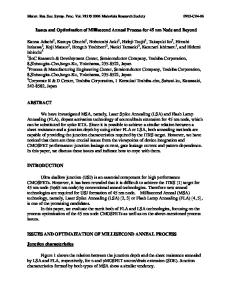Ultra-Shallow Junction Formation Technology from the 130 to the 45 nm node
- PDF / 368,671 Bytes
- 12 Pages / 612 x 792 pts (letter) Page_size
- 108 Downloads / 330 Views
C5.6.1
Ultra-Shallow Junction Formation Technology from the 130 to the 45 nm node Amitabh Jain Silicon Technology Development, Texas Instruments Inc., Dallas, Texas 75243, U.S.A. ABSTRACT One of the main materials challenges of the 130 nm silicon technology node was the need to find a processing solution to the anomalous diffusion behavior of ion-implanted dopants known from three decades of research. Reduction of implantation energy no longer proved sufficient when trying to reduce source/drain extension junction depth, increase abruptness, and limit sheet resistance. Spike-annealing, a new process in which ion implanted silicon could be heated rapidly to temperatures required for dopant activation and then cooled down without dwelling at temperature, adequately addressed the scaling requirements of this node. The resulting junctions achieved high dopant concentration values very close to the surface while limiting junction depth. However, this increased the propensity for dopant migration to overlying layers associated with the source/drain spacer. Loss of device performance due to this and other phenomena became a strong motivating factor for further materials research in order to sustain progress through the 130 nm and 90 nm nodes. Complex interactions between various layers have been understood and the resulting developments in spacer materials have enabled high performance devices. The requirements of the 65 and 45 nm nodes stretch spike-annealing to its limit and newer Ultra-High Temperature anneals must be considered. INTRODUCTION Since the early days of ion implantation [1] the possibility of developing low thermal budget processes for the doping of semiconductors has been an attractive proposition. The reasons have changed over time. In the early days the motivation was simply to avoid high temperatures since the furnaces in the sixties introduced considerable contamination. In recent years the exploration of low thermal budget processes has been an imperative imposed by scaling requirements. The abiding interest over several decades has however led to the discovery and understanding of anomalous diffusion effects of dopants in silicon when annealing at low temperatures or over short time scales. Webber et al. [2] reported the reverse annealing of B in Si at intermediate temperatures. North and Gibson [3] showed this to be related to the movement of substitutional B out of lattice sites. Wu and Washburn [4] discovered the complex evolution of defects in B ion implanted silicon at these temperatures. Their remarkable in-situ time-lapse transmission electron micrographs showed rod-shaped defects evolving into dislocation loops. Salisbury and Loretto [5] first identified rod-shaped defects as the precipitation of self-interstials on the {113} plane and described how they may unfault. Michel et al. [6] characterized anomalous diffusion and the existence of a transient stage connected to the evolution of defects. Giles [7] developed a model to explain transient diffusion in terms of defect evolution. Our curre
Data Loading...











